List of Iranian dynasties and countries
The following is an incomplete list of historical dynasties which were at some time Iranian or the country they ruled were Iranian-speaking and of modern countries with significant Iranian populations or with an official Iranian language. The Iranians consist of Persians, Medes, Scythians, Kurds, Bactrians, Pashtuns, Tajiks, Baloch, Parthians, Sarmatians, Alans, Ossetians, Cimerians, and many more peoples.
Current states
Independent states
 Iran
Iran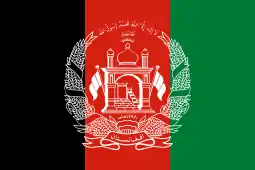 Afghanistan
Afghanistan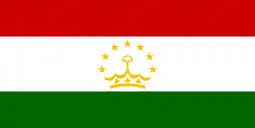 Tajikistan
Tajikistan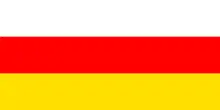 South Ossetia (de facto) in Georgia
South Ossetia (de facto) in Georgia
Federal subjects of Russia
Autonomous regions
Historical confederation of tribes and Iranian dynasties
Direct Iranian dynasties
- Medes (ca. 678 BCE–549 BCE) of Median origin
- Orontid dynasty (570–200 BC) of Iranian origin[1][2][3][4][5]
- Achaemenid Empire (550–330 BC) of Persian origin
- Atropatene (320s BC–3rd century AD) of Iranian origin
- Mithridatic dynasty (281-47/37 BC) of Persian origin
- Parthian Empire ("Arsacid dynasty of Parthia"; 247 BC–224 AD) of Parthian origin
- Arsacid dynasty of Armenia (52–428) of Parthian origin
- Arsacid dynasty of Iberia (c. 189–284) of Parthian origin
- Arsacid dynasty of Caucasian Albania (1st century-510) of Parthian origin
- Indo-Scythians (200 BCE–400 AD) of Scythian origin
- Shule Kingdom (200 BC–790 AD) of Sakan origin
- Artaxiad dynasty (190 BC-12 AD) of Iranian origin
- Indo-Parthian Kingdom (12 BC–before 100 AD?) Of Parthian origin
- Kingdom of Khotan (56–1006) of Sakan origin
- Sasanian Empire (224–651) of Persian origin
- Chosroid dynasty (284–807) of Iranian origin
- Mihranids (330–821) of Iranian origin
- Afrighids (305–995) of Khwarezmian origin
- Dabuyid dynasty (642–760) Of Persian and Tabari origin
- Masmughans of Damavand (650–760) Of Parthian origin
- Bavand dynasty (651–1349) Of Parthian origin
- Paduspanids (665–1598) of Persian and Tabari origin
- Bukhar Khudahs (before 681-890s) of Sogdian origin
- Principality of Ushrusana (???-892/3) of Sogdian origin
- Qarinvand dynasty (7th-century–11th-century) of Parthian origin
- Rustamid dynasty (767–909) of Persian origin
- Justanids (791–974) of Dailamite origin
- Shirvanshah (1207–1607) originally of Arab origin, but speedily Persianized[6][7] within their culturally Persian environment.[7]
- Samanids (819–999) of Persian origin
- Tahirid dynasty (821–873) of Persian origin
- Banijurids (848–908) of Persian origin
- Saffarid dynasty (861–1003) of Persian origin
- Sajid dynasty (889/890–929) of Sogdian origin
- Farighunids (10th century-1010) of Persian origin
- Sallarid dynasty (919–1062) of Dailamite origin
- Ziyarid dynasty (931–1090) of Dailamite origin
- Banu Ilyas (932–968) of Sogdian origin
- Buyid dynasty (934–1055) of Dailamite origin
- Shaddadids (951–1174) of Kurdish origin
- Marwanids (990–1085) of Kurdish origin
- Ma'munids (995–1017) of Khwarezmian origin
- Kakuyids (1008–1141) of Dailamite origin
- Ghurid Dynasty (1011–1215) of Tajik origin
- Nasrid dynasty (Sistan) (1029–1225) of Persian origin
- Hazaraspids (1115–1424) of Kurdish origin
- Atabegs of Yazd (1141–1319) of Persian origin
- Ayyubid dynasty (1171–1341) of Kurdish origin
- Principality of Bitlis (1182–1847) of Kurdish origin
- Mihrabanids (1236–1537) of Persian origin
- Kurt Dynasty (1244–1381) Of Tajik origin
- Afrasiab dynasty (1349–1504) of Iranian origin
- Marashis (1359-1596) of Mazandarani origin
- Lodi dynasty (1451-1526) of Pashtun origin
- Mirani dynasty (1476-1787) of Baloch origin
- Sur Empire (1540–1556) of Pashtun origin
- Safavid dynasty (1501–1736) of Kurdish origin
- Kalhora dynasty (1701-1783) of Baloch origin
- Zand dynasty (1750–1794) of Luri origin
- Afsharid dynasty (1736–1796) Iranian dynasty of Turkic origin
- Qajar dynasty (1789–1925) Iranian dynasty of Turkic origin
- Hotaki dynasty (1709–1738) of Pashtun origin
- Talysh Khanate (1747–1826) of Talysh origin
- Durrani Empire (1747–1862) Pashtun origin
- Talpur dynasty (1783–1843) of Baloch origin
- Barakzai dynasty (1826–1973) Pashtun origin
- Pahlavi dynasty (1925–1979) of Mazandaran origin
Former and defunct Iranian governments
 Khanate of Kalat (1666–1955)
Khanate of Kalat (1666–1955) Persian Socialist Soviet Republic (1920–1921)
Persian Socialist Soviet Republic (1920–1921).svg.png.webp) Autonomous Government of Khorasan (1921)
Autonomous Government of Khorasan (1921).svg.png.webp) Kingdom of Kurdistan (1921–1924)
Kingdom of Kurdistan (1921–1924) South Ossetian Autonomous Oblast (1922–1990)
South Ossetian Autonomous Oblast (1922–1990)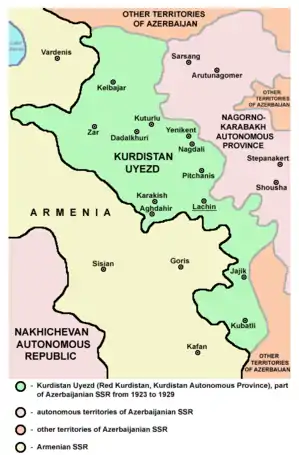 Kurdistansky Uyezd (1923–1929)
Kurdistansky Uyezd (1923–1929).png.webp) Republic of Ararat (1927–1930)
Republic of Ararat (1927–1930)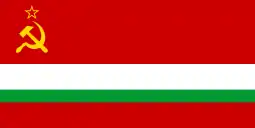 Tajik Soviet Socialist Republic (1929–1991)
Tajik Soviet Socialist Republic (1929–1991) North Ossetian Autonomous Soviet Socialist Republic (1936–1992)
North Ossetian Autonomous Soviet Socialist Republic (1936–1992)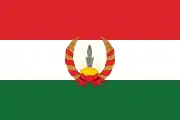 Republic of Mahabad (1946–1947)
Republic of Mahabad (1946–1947) Baluchistan States Union (1952-1955)
Baluchistan States Union (1952-1955).jpg.webp) Talysh-Mughan Autonomous Republic (1993)
Talysh-Mughan Autonomous Republic (1993)
See also
Notes
References
- Allsen, Thomas T. (2011). The Royal Hunt in Eurasian History. University of Pennsylvania Press. ISBN 978-0812201079. p. 37.; "The Orontid dynasty of Armenia (ca. 401-200), whose ruling house was of Achaemenid origin, originally administered the territory as satraps and later as independent kings."
- Sartre, Maurice (2005). The Middle East Under Rome. Harvard University Press. ISBN 978-0674016835. p. 23; "The Commagene kings claimed to be descended from the Orontids, a powerful Iranian family that had ruled the area during the Achaemenid period. They were related to the Achaemenids who had built a kingdom (...)".
- Babaie, Sussan.; Grigor, Talinn. Persian Kingship and Architecture: Strategies of Power in Iran from the Achaemenids to the Pahlavis. (2015). I.B.Tauris. ISBN 978-1848857513. p. 80.; "Iranian culture deeply influenced Armenia, and Iranian dynasties ruled Armenia during several important periods, including the Orontids (c. sixth century – c. early second century BCE) and Arsacids (54–428 CE)."
- TIGRAN II. Garsoian, N. (2005). Encyclopaedia Iranica. quote = "Tigran (Tigranes) II was the most distinguished member of the so-called Artašēsid/Artaxiad dynasty, which has now been identified as a branch of the earlier Eruandid [Orontid] dynasty of Iranian origin attested as ruling in Armenia from at least the 5th century B.C.E."
- Cyril Toumanoff (Georgetown University Press, 1963; Studies in Christian Caucasian History, part III. The Orontids of Armenia. ). p. 278; "The eponym's praeonemen Orontes is as Iranian as the dynasty itself, derived from the Avestan auraund/aurvant ('mighty,' 'hero') and related to the Pehlevi arvand."
- Barthold, W., C.E. Bosworth "Shirwan Shah, Sharwan Shah. "Encyclopaedia of Islam. Edited by: P. Bearman, Th. Bianquis, C.E. Bosworth, E. van Donzel and W.P. Heinrichs. Brill, 2nd edition
- C.E. Bosworth, "ŠERVĀNŠAHS" in Encyclopaedia Iranica. Excerpt 1: "ŠERVĀNŠAHS (Šarvānšāhs), the various lines of rulers, originally Arab in ethnos but speedily Persianized" Excerpt 2:" ). Just as an originally Arab family like the Rawwādids in Azerbaijan became Kurdicized from their Kurdish milieu, so the Šervānšāhs clearly became gradually Persianized, probably helped by intermarriage with the local families of eastern Transcaucasia; from the time of Manučehr b. Yazid (r. 418-25/1028-34), their names became almost entirely Persian rather than Arabic, with favored names from the heroic national Iranian past and with claims made to descent from such figures as Bahrām Gur".
This article is issued from Wikipedia. The text is licensed under Creative Commons - Attribution - Sharealike. Additional terms may apply for the media files.